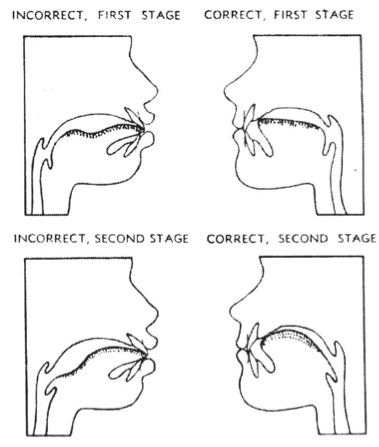Role of Speech Therapy in Orthodontic Treatment
Clik here to view.

patient before treatment
Clik here to view.

After treatment
As a practicing orthodontist, we treat all kinds of malocclusions in children and adults. Most of our patients come to our office seeking treatment because their teeth looks crooked or, less commonly, because their teeth do not function properly. Rarely do they come complaining of poor swallowing or tongue thrusting, or of a speech impediment. However, the root cause of some unsightly bites and speech impediments is the fact that they do not swallow properly.
Clik here to view.

Tongue-thrust diagrams
Swallowing is a more complicated activity than most people realize. It involves muscles and nerves of the tongue, cheeks and throat. In some people, these muscles and nerves retain an “infantile” or protrusive position during swallowing. Swallowing in babies with no teeth is programmed to provide suction to the breast, facilitate “suckling”, the act of stimulating lactation and provide ingestion of milk without breaking the seal to the breast.
Clik here to view.

Open bite example
The action of this “infantile” swallowing is very different from normal chewing and swallowing of an older person who is not breast feeding. The transition from infantile swallowing to normal swallowing occurs usually before the age of 6; thus before the development of adult dentition. The swallow may also be modified later as the child grows, by thumb or finger sucking habits or other “mouth habits”. Due to the close proximity of the teeth to the muscles affecting swallowing, normal growth and development of the dentition may be affected by abnormal swallowing pattern.
Clik here to view.

Example of tongue-thrust
Clik here to view.

Tongue-thrust patient
Proper mature swallowing pattern places the tongue up against the roof of the mouth, or hard palate, with the tip of the tongue resting slightly behind the upper front teeth. The shape of the hard palate is influenced by this muscular and “suctional” pressure. A person who swallows incorrectly, such as in the case of infantile swallow, will place the tongue against the teeth. The pressure from the tongue, which can be a few ounces to several pounds with each swallow, will now displace and misalign teeth,. This misplaced action is a significant force, since we swallow about 2000 times a day, even when we sleep. Depending on the pressures of the tongue, cheeks, lips, and throat, malocclusions created by abnormal swallowing pattern can be manifested in ways such as upper protruded teeth or “buck teeth”; anterior open bite, posterior open bite, or constricted upper arch.
Such malocclusions or faulty bites are not only unsightly, but can also cause serious problems that may affect one’s dental health, nutritional balance, or speech problems. We help provide solutions for patients each and everyday at our Surrey and Vancouver Offices.
The post Role of Speech Therapy in Your Orthodontic Treatment appeared first on Pacific West Dental.